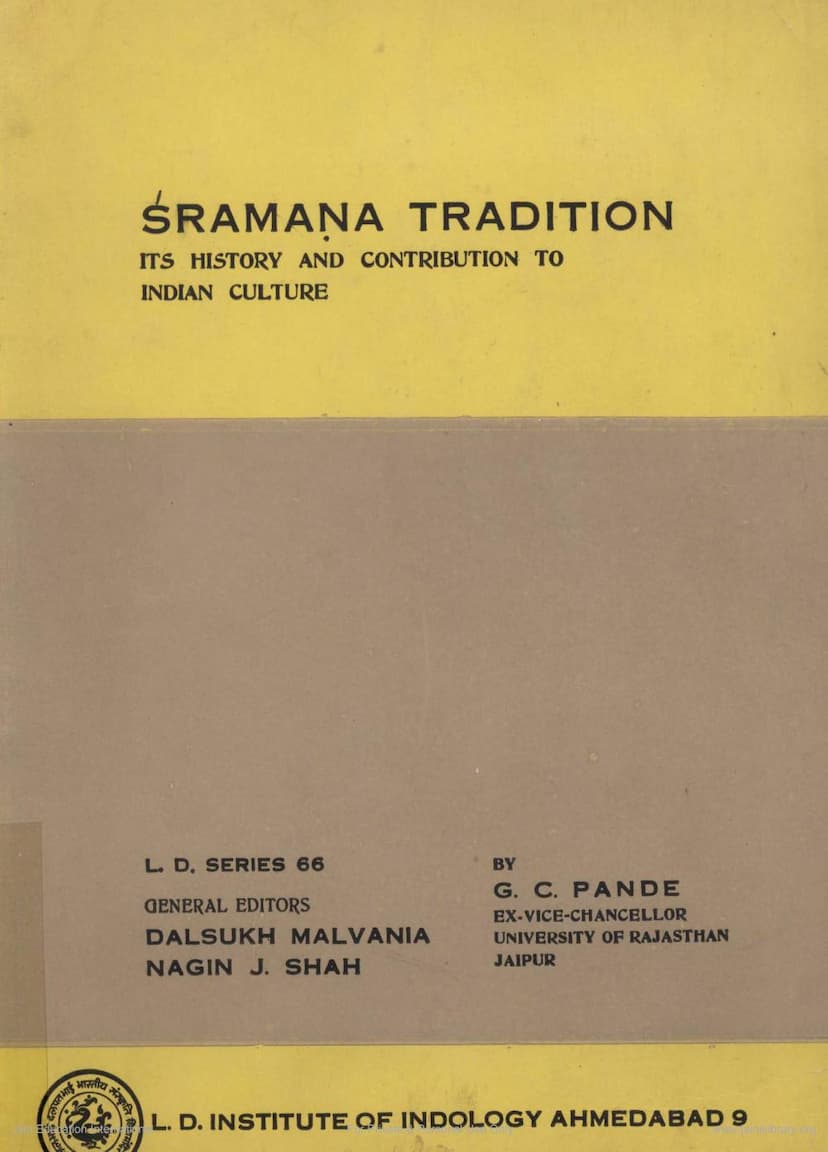Sramana Tradation
Added to library: September 2, 2025

Summary
This comprehensive summary of G. C. Pandey's "Śramaņa Tradition: Its History and Contribution to Indian Culture" synthesizes the information provided across the initial pages of the book, including the preface, introduction, and the start of the first lecture.
Book Overview:
"Śramaņa Tradition: Its History and Contribution to Indian Culture" by G. C. Pandey, published by L. D. Institute of Indology, Ahmedabad, in February 1978, is a collection of three lectures delivered in February 1977. The book explores the historical development and cultural impact of the Śramaņa tradition, primarily focusing on its relationship with and critique of the Vedic (Brahmanical) tradition in ancient India.
Key Themes and Arguments:
The work emphasizes the dialectical interplay between two major spiritual attitudes in Indian culture: Pravṛtti (engagement with the world) and Nivṛtti (withdrawal from the world). Pandey argues that while both Brahmanism and Śramaṇism contributed to the development of Indian culture, Śramaṇism, with its emphasis on asceticism, renunciation, and a critical stance on existing social and religious norms, posed a significant "negative challenge" to the prevailing Vedic worldview.
Introduction Highlights:
- Culture vs. Civilization: Pandey distinguishes between culture as the spiritual search for values and civilization as the means for social security and material progress. He notes that while civilization is inherently composite and open to external influences, culture possesses an inner ethos that provides unity and vitality.
- Pravṛtti and Nivṛtti: He traces the dialectical interweaving of these two attitudes throughout Indian history, challenging the notion that both originated solely within the Vedic tradition. He hints at the possibility of Śramanic elements existing even in the Indus Valley Civilization.
- The Śramaņic Challenge: The core of the lectures, as outlined in the introduction, is to explore the Śramaņic challenge to Brahmanism, particularly concerning the caste system, the authority of the Vedas, and the concept of God.
Lecture One: Śramaṇism as a Weltanschauung and its Relationship to the Vedic Tradition:
- Core Śramaņic Beliefs: Pandey highlights that Śramaņa sects rejected Vedic authority and the concept of a personal creator God, leading them to be labeled "Nāstika" (heterodox or nihilist). The fundamental dividing line, he argues, was the doctrine of Karma.
- Origins and Influences: He discusses various theories about the genesis of the Śramaņic movement, including reactions to Vedic ritualism, social changes, and the possibility of an ancient tradition independent of the Vedic Aryans. He notes the presence of heterodox thinkers even within Upanishadic literature.
- Upanishadic Interaction: Pandey examines specific Upanishadic passages (Chāndogya, Bṛhadāraṇyaka, Katha, Mundaka) to trace the growing influence of Śramanic ideas. He points out concepts like Karma, rebirth, asceticism, and the questioning of traditional rituals as echoes of the Śramaņic worldview finding their way into Vedic thought. However, he also emphasizes that Upanishadic thought generally retained a more positive and life-affirming stance compared to the radical renunciation of Śramaṇism.
- Distinction from Vedic Outlook: He contrasts the Vedic tradition's emphasis on Rta (cosmic law), social and ritual obligations, and a generally optimistic view of life with the Śramaņic focus on Karma, renunciation of desires, and the pursuit of liberation from the cycle of existence.
Overall Argumentative Thrust:
Pandey's approach is characterized by a detailed analysis of textual evidence, aiming to demonstrate that the Śramaņa tradition was not merely a reactive movement but a distinct and ancient stream of thought that profoundly shaped Indian culture. His work seeks to understand the dynamic interaction and synthesis between Brahmanism and Śramaṇism, highlighting how Śramaņic critiques led to significant transformations within the Brahmanical tradition itself. The lectures promise a critical examination of Śramaņic contributions to Indian ethical, social, and philosophical thought, emphasizing its rational, ethical, and universalistic dimensions.